WD Red Pro Review: 4 TB Drives for NAS Systems Benchmarked
by Ganesh T S on August 8, 2014 9:00 AM ESTPerformance - Raw Drives
Prior to evaluating the performance of the drives in a NAS environment, we wanted to check up on the best-case performance of the drives by connecting them directly to a SATA 6 Gbps port. Using HD Tune Pro 5.50, we ran a number of tests on the raw drives. The following screenshots present the results for the various drives in an easy-to-compare manner. Note that some of the screenshots are from the previous roundup where we used HD Tune Pro 5.0.
Sequential Reads:
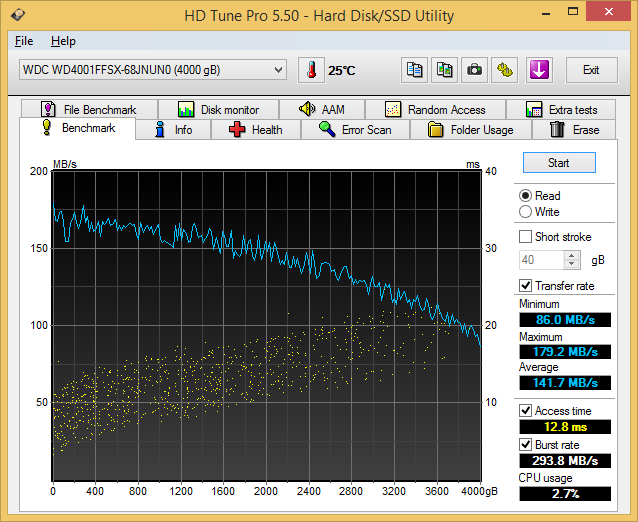
Sequential Writes:
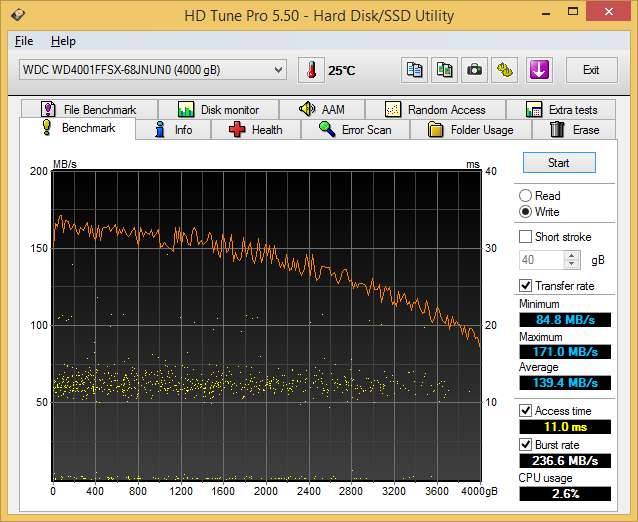
Random Reads:
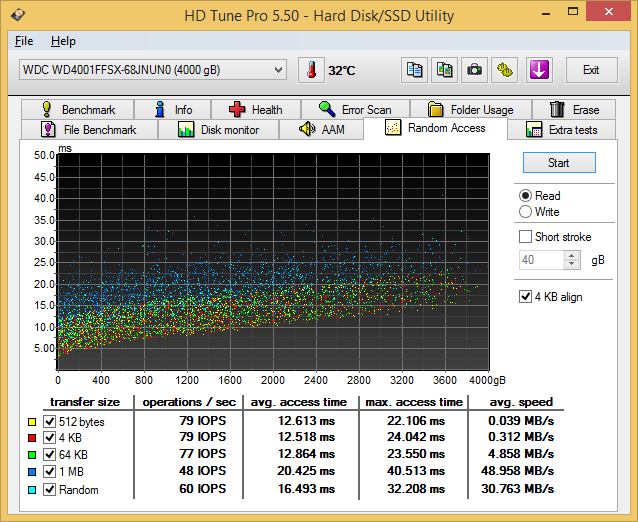
Random Writes:
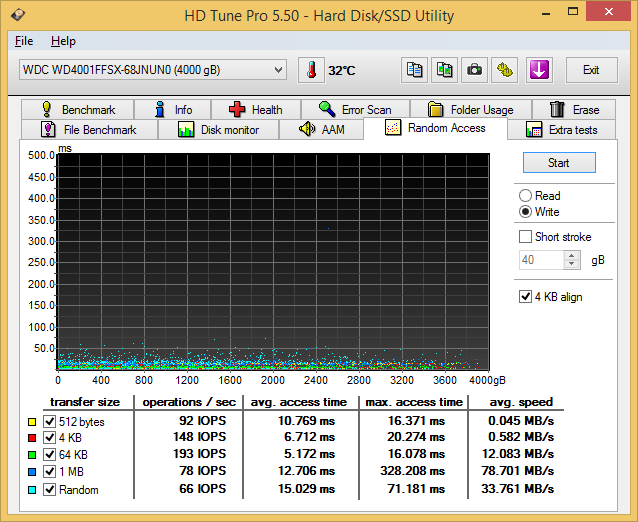
Miscellaneous Reads:
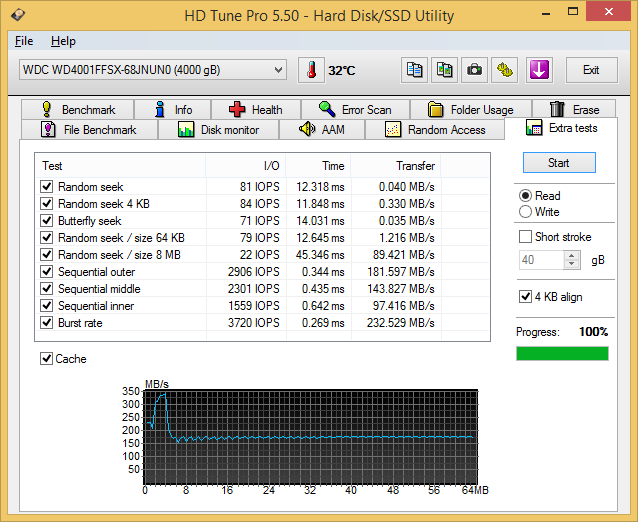
Miscellaneous Writes:
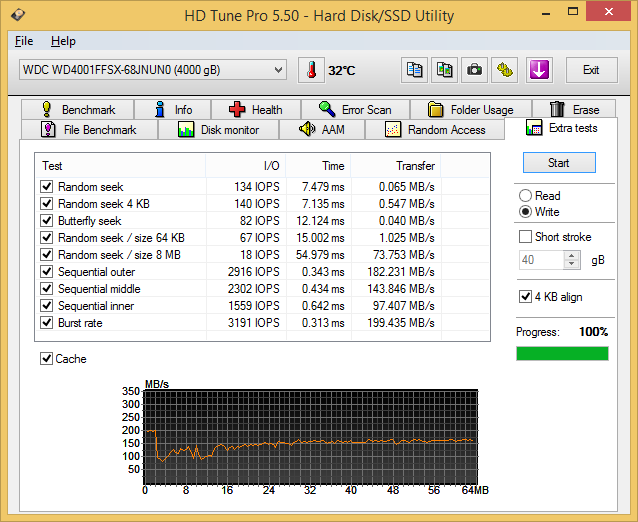










62 Comments
View All Comments
jabber - Friday, August 8, 2014 - link
So actually nothing important. When I see these NAS/Storage articles I just can't help with a lot of eye-rolling at what folks write. Folks spending large amounts of effort and money on data that is of little value to anyone or anything.I best most here would actually get by with a 2TB external USB3 HDD.if they were honest. Oh and that includes the business they work for.
jaden24 - Friday, August 8, 2014 - link
Well, what you are calling unimportant is a very subjective statement. To me, spending large amounts of time, effort and money is extremely worth it. Also, much of it has paid off over time since I have properly implemented good practices. This has allowed me to share a library of movies, tv shows and music with my family in 5 different rooms via XBMC because it is all centrally located.Having done all of that work to offer this content would be a total waste if I didn't take proper measures to ensure it is backed up. Surely, it wouldn't be smart to let an array fail and have to re-encode and format all of that data all over again; now that would take a lot of wasted time and effort.
Besides, a 2TB external HDD would have to be USB3 (possibly with UASP) and hooked to a USB3 controller to achieve decent, multiple streams, but it wouldn't have redundancy. Also, 2TB is only going to hold so many movies. What if you like 400-480p movies, but I prefer 720-1080p movies? All of this comes down to preference, and this alone is what determines each of our own setups to suit our tastes.
sapius1 - Friday, September 26, 2014 - link
I am a professional photographer and generate about 1TB/year of original content (growing each year). I absolutely need more than a 2TB external HDD.m2inor - Saturday, August 9, 2014 - link
It's very easy to legitimately consume more than 200GB on any computer let alone a server:- I believe in having multiple copies of personal docs and media I created: photos, personal videos, emails, installers, projects, etc
- if you have multiple desktops and laptops, each should be backed up
- and don't forget to backup the backup devices :-)
Do that for 30 years, and you'll have quite a collection. Only the inciminating evidence should be deleted on a regular basis.
Oh, and you'll only need that one file a few days after you delete it.
dcaxax - Friday, August 8, 2014 - link
When comparing NAS drives, reliability is by far the #1 concern. Power consumption and noise are also important, but by no means the deciding factor.Testing the WD Red drives (especially given the pretty high failure rates of the plain WD Reds) without saying something about reliability makes the whole article pointless.
IF the drives are reliable, people will chose them over faster, chepaer and probablyn even noisier drivers. If you're going to to do this you needs to test at least 10-20 drives and come up with some kind of torture test to really push them.
jaden24 - Friday, August 8, 2014 - link
This is exactly why I only buy hard drives with 5yr warranties. The length of a warranty tells you a lot about the confidence of a manufacture in their product. When bad luck does arise, (usually around the 3-5yr range), you have a drive that gets replaced with no questions asked. At least that is my experience with WD.cen - Friday, August 8, 2014 - link
Too bad HGST couldn't send the deskstar version.. I bought 4 of them a month ago for my FreeNAS build, excellent drives.bsd228 - Friday, August 8, 2014 - link
Ganesh - can you put some questions out to the manufacturers and write a short article on the relevance of URE? I find it very hard to take this metric seriously when consumer drives are all marked as 'better than 1 in 10^14,' a nice round number that hasn't changed in a decade (forever?). Has there really been no improvement? Are they all really the same? And are enterprise drives precisely 10x better? Unlikely. And what is really different about them?shodanshok - Saturday, August 9, 2014 - link
Hi,We recently discussed the URE thing on the Linux raid mailing list. You can found more info here: http://marc.info/?l=linux-raid&m=1406791003244...
asmian - Saturday, August 9, 2014 - link
1 post is not a "discussion". And while this may be relevant for Linux users, it doesn't help anyone else, perhaps running RAID on Windows or using a NAS, for which some at least of these drives are marketed.In the last discussion on this here, there was mention that ZFS (at least with double parity) can avoid UREs affecting array rebuilds. However, it looks as if Storage Spaces and the new ReFS file system now in Windows 8.1 and Windows Server can achieve the same thing as ZFS with much lower system resources (although it is necessary to bypass the Storage Spaces UI on Windows 8.1 for proper configuration). Can anyone share any experience of using ReFS, since this is quite new and directly challenges the Nas4Free/FreeNas route which requires FreeBSD as an OS? In particular, it makes a single media storage server/HTPC combo a feasible proposition, which might be very useful for many...